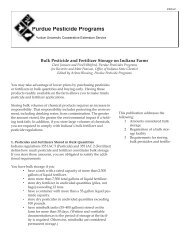Pesticides and Risk Communication PPP-52 - Purdue Pesticide ...
Pesticides and Risk Communication PPP-52 - Purdue Pesticide ...
Pesticides and Risk Communication PPP-52 - Purdue Pesticide ...
Create successful ePaper yourself
Turn your PDF publications into a flip-book with our unique Google optimized e-Paper software.
your time frame. For example, limit your presentation to perhaps half<br />
the allotted time <strong>and</strong> spend the remainder listening to your audience<br />
<strong>and</strong> addressing their specific anxieties. Draw them into the subject.<br />
Listen to them. Carefully. Discuss their concerns c<strong>and</strong>idly. They will<br />
remember who you are, <strong>and</strong> they will seek you out the next time they<br />
have concerns. You will depart with new friends, new contacts. And they<br />
will, too.<br />
You’ve Got 20 Minutes to Set the Hook<br />
The human brain works in cycles of attentiveness <strong>and</strong> inattentiveness,<br />
<strong>and</strong> the attention span of the learner generally is about 20 minutes.<br />
After 20 minutes, attention often is diverted elsewhere, <strong>and</strong> a<br />
period of inattentiveness may prevail for several minutes before the<br />
brain refocuses on the speaker. This cycle can repeat several times<br />
during a 60-minute presentation, but adding a twist to your delivery<br />
every 15 to 20 minutes helps rejuvenate your listeners.<br />
State Your Purpose<br />
Continually remind people what you are trying to accomplish <strong>and</strong><br />
where you are in the program.<br />
What Did You Say? I Can’t Hear You!<br />
Always use a microphone in a large room. It is important that everyone<br />
is able to hear your presentation without difficulty.<br />
Connect the Dots to the Bigger Picture<br />
Think of the issue in stages or steps, <strong>and</strong> present them in order—but<br />
don’t be boring! Explain <strong>and</strong> demonstrate the logical steps in drawing<br />
valid conclusions. Impress upon the audience the basics of reasonable,<br />
accurate risk assessment; that is, replace the mystery component with<br />
knowledge <strong>and</strong> technique.<br />
What I Know About <strong><strong>Pesticide</strong>s</strong><br />
Comes from DDT <strong>and</strong> Agent Orange<br />
Offer complete information on the benefits <strong>and</strong> risks of the pesticide<br />
being discussed. Most issues involve trade-offs, so present both ends of<br />
the spectrum <strong>and</strong> encourage discussion. Conclude by summarizing<br />
what has been addressed <strong>and</strong> offer your own slant, if appropriate;<br />
sometimes it is better left to the audience to form their own conclusions.<br />
44




